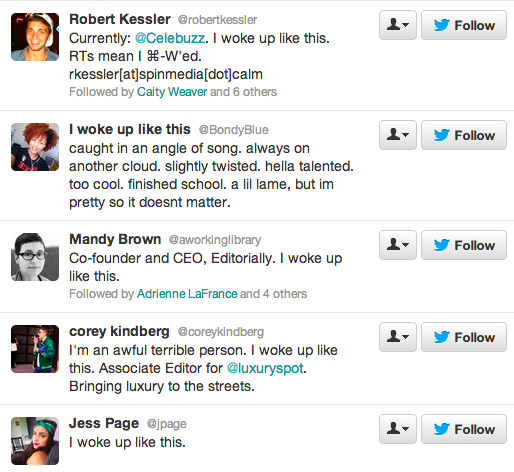
Earlier this week I "nuked" my Twitter feed. The feed was beyond trimming or manicuring — it was time to execute a complete reset. The process was refreshing. And somewhat illuminating! It was also time-consuming, and, frankly, less than half the battle. I had blown up my feed. Next, I needed to make a better one.
The idea was never to recede from Twitter or switch to a broadcast-only model. It was to try to reconstruct a feed that was more efficient and more enjoyable than the one I had built, piecemeal, over five years. I wanted a lean, efficient, useful feed, absent of any baggage. This, it turns out, is pretty hard.
My first move was the easiest. I needed to inject some life to my feed, so I added people I see every day or week. These are the people most likely to respond to my stupid jokes, basically. The regulars. My weird little Twitter version of Cheers. In my case, this meant a lot of co-workers and younger reporters who are high-volume tweeters, but with whom I'm used to interacting. Adding "regulars" made my feed feel familiar again, but more importantly, it brought back a sense of immediacy.
The regulars were easy to find. But the process quickly became a test: of my resolution to be more judicious with my follows; of my ability to resist the pressure of guilt-follows, pity-follows, follow-backs; of my resistance to the very Twitter conventions that turned my last feed into a nightmare. While a modicum of civility is always nice online, on a second look, I can't regard the whole #followback ethos, whether formalized or not, as anything but completely ridiculous. Anyone who uses Twitter daily as a tool for work reserves the right to be as ruthless with feed curation as they see fit. It's just not worth the time and energy. A courtesy follow is a small favor that can turn into a huge pain in the ass.
Anyway: With a familiar core in place, I turned to lists. First I created custom lists in Tweetdeck to mimic the timelines of some of my colleagues (other tech reporters). Scanning their ghost timelines for a few minutes quickly surfaced some reliable, familiar accounts, which I followed. When a particularly good account would surface (a smart journalist or a news organization with a savvy social media team), I would check their account for lists or simply look into their follows. Since most lists are curated according to a theme, I was able to save hours.
I asked peers and co-workers for their personal tips, one of which became a sort of guiding principle: Rather following entire mastheads of journalists/reporters from a publication or organization, just follow a single writer that represents the entire team, or the part of it that you care about. There's a decent chance they'll have public conversations with their colleagues and tweet their work. It's imperfect, but a good way to reap the benefits of a larger network while following fewer people. Let them expend energy for you, and just take what you need.
Lastly, I decided to forego almost all brands and news organization accounts. Generally, these are some of the highest-volume accounts and, in the cases of brands, they're really only worth following when they screw up. News organizations tend to overlap with each other, clogging feeds with what are essentially duplicate tweets. For news organizations essential to my beat, I decided to follow only accounts that make a point to share articles from other sites. Recode, a new tech venture, for example, is excellent about sharing work by other people, making it an easy exception.

Anyway, a few more observations:
• Twitter bios were more important than I would have anticipated. When you scroll through lists looking for accounts to follow, it basically provides your first and only impression. A really good, funny bio drew me to profiles I had little business following and, in some cases, even coaxed a follow. Originality was as important as being clear about who you are. Also, I probably scrolled through well over 10,000 individual accounts in the past few days. I'd estimate that between 5 to 10% included or consisted only of the Beyoncé lyric "I woke up like this."
• Dedicated retweeters on specific beats are invaluable. For example, my colleague Dorsey Shaw covers and tweets a lot about cable news, usually including retweets of the best nuggets from others on his beat. I have only a passing interest in cable news, so one good curator is more than enough. I think I should probably tweet a little bit more like that. I watched this tactic pay dividends during yesterday's Chris Christie press conferences. Following just a few good accounts from "politics Twitter" gave me a sense of what was going on, which jokes were being made over and over, but it it was relatively low volume and over quickly.
• The reset gave me a chance to ditch some of the people whose Twitter presence is especially grating. Oddly enough, I found myself refollowing a couple of these people. It's a personal choice, but for me, the perfect feed should be at least 10% infuriating.
• While I'm ashamed to admit it, building out my feed made me think critically for the first time about the gender balance and racial diversity of my feed. Before the purge, my feed, which was assembled in small parts over a long period, in the contexts of industries that have their own issues with diversity, was predominantly white and male. While I can't say confidently that my feed is now a paragon of diversity, the process of cleaning out and rebuilding has made me far more aware of its composition.

As of this writing, I'm back up to around 175 accounts. I can easily see that number ballooning back up past 600 or maybe even topping out around 1,000. I will not let it approach 2,000, as it did before.
Eliminating most of the noise from my feed helped me realize just how tolerant I had become of said noise. When I mentioned the possibility of getting back to 1,000 follows to another writer, he almost laughed: "You just told told everyone to pare down!" In some respects he's right, but it misses the bigger point of nuking your Twitter feed, which is to understand what exactly it is I'm getting from this incredibly distracting service, and to get a little more. Even if I followed 2,000 people again, I like to think they'd be a much better mob (for my purposes) than the last.
@cwarzel (none of this matters)

⟠Jenna Wortham âŸ
@jennydeluxe
@cwarzel (none of this matters)
Most often through this process, I was reminded how impermanent and inconsequential these decisions actually are. While my Twitter network is important to me both personally and professionally, the process of building it — this time and last — is nothing more than a series of snap decisions usually rooted deeply in the context of the moment, many of which will later be revealed as mistakes. Twitter is a tool and a service where the cost of each follow and unfollow is minuscule and should be treated as such. The only universal lesson of the reset experiment is this: You'll need to make it a habit. It's a fix, but a temporary one.
So add and follow with impunity. It's your feed after all.
